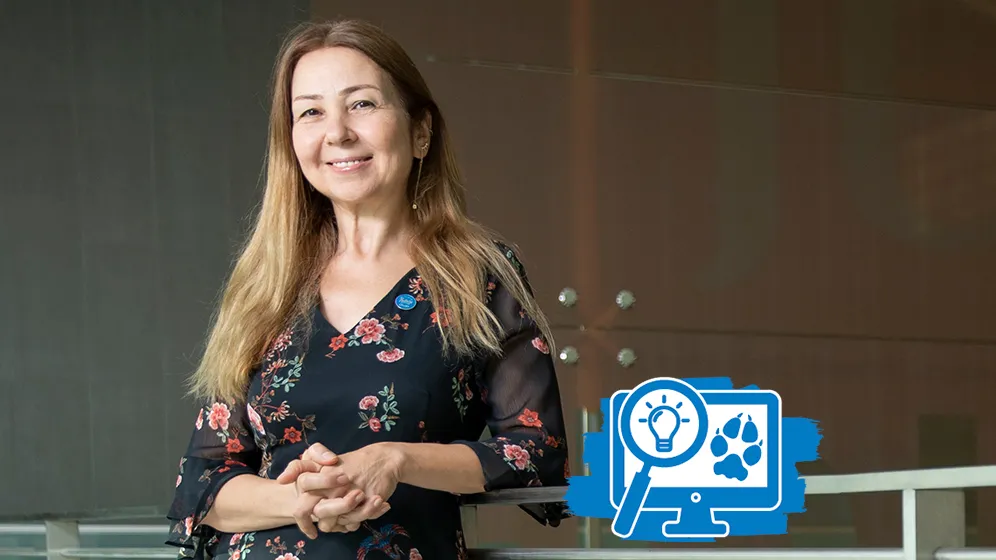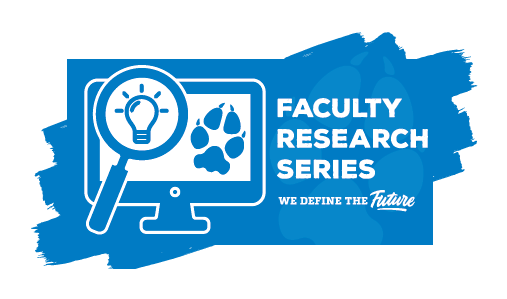Joe Gutierrez | CSUSB Office of Strategic Communication | (951) 236-4522 | joeg@csusb.edu

Editor’s note: This part of a series of profiles of faculty and their research by Montgomery Van Wart, a professor of public administration and a CSUSB Faculty Research Fellow in Faculty Affairs and Development. In this article, he features Gölge Seferoğlu, associate professor of teacher education and foundations.
By Montgomery Van Wart
Rarely is there a single way to do research, especially in the social sciences where the complexity of human nature makes classic experimental designs difficult and limiting. So unlike natural scientists who generally perfect a limited number of research designs, social scientists tend to use a wider variety of designs.
Rather than finding a single answer, social sciences tend to look for clusters of interrelated answers, taking the discovery- and process-oriented, insider perspective. As the great American anthropologist Zora Neale Huston said: “Research is formalized curiosity. It is poking and prying with a purpose.”

Gölge Seferoğlu, an associate professor of teacher education and foundations in the College of Education at Cal State San Bernardino, is a fine example of a social scientist who uses a wide variety of research designs to learn about the complex processes of facilitated second-language learning.
“My motto in life also underlies my teaching and research philosophy: ‘Live to Learn, Learn to Live.’ This provides me with an approach to life and work,” said Seferoğlu. “I love creating opportunities for sharing practices, experiences and research.”
Social scientists frequently use a close cousin of the experimental design called the quasi-experimental experimental design in which there is a treatment group and a control group (because of the near impossibility of guaranteeing true randomness of the subjects), and both groups are pre- and post-tested.
For example, in one study Seferoğlu studied improving students’ pronunciation through accent reduction software. Two classes participated in the study. While one class (the control group) followed traditional instruction, the other class (the experimental group) followed instruction that integrated use of accent reduction software in a multimedia language laboratory. Based on the results of the study, it was demonstrated that technology has a lot to offer language learners.
In correlational analysis you study the interaction of two or more variables. In a study about teachers’ career plans, she analyzed factors such as the type of institutions chosen, the regions of the country from which the teachers came, and the personal goals of the subjects.
Much of her research involves quantitative field research in which you go to field (i.e., live settings) to test alternative explanations. Using a conversation analytic framework in a field setting, Seferoğlu looked at alternative ways teachers manage student-initiated word searches in English-as-a-Foreign-Language (EFL) classrooms.
A common design in the social sciences is the use of narrative analysis in which a story is woven around events and which aims for a deep exploration of the meanings people assign to their experiences, generally using a small sample. Seferoğlu used such an approach in a study called: “Identity Narratives of Early Career English Language Teachers: Similar Paths, Divergent Practices.”
A related design is called phenomenological in which an event, activity or phenomenon is described through a rigorous methodology but with no prior hypothesis. It allows people’s lived experience to emerge from research for novel insights. An example of such a study involved teacher professionalism and the motives that drive and sustain professional practices.
Grounded theory design has a similar approach in that it aims at an explanation for events or trends from open-ended methods, but explores behavioral reaction or response patterns, continuing to investigate until a handful of patterns crystalize. In a study on the qualities and qualifications of EFL professionals by program directors, a thematic analysis of the data revealed the importance of having vitality of language proficiency, openness for professional development and self-reflection, character, and pedagogical knowledge in ideal applicants for teaching positions.
Seferoğlu also frequently uses case study design in which the researcher is seeking a deep understanding of a cluster of interrelated data sources to explain an example of success/failure, a specific learning process, etc. A frequent instance of case study design in teaching is analyzing a specific teaching tool, such as the use of feature films in language classes.
Sometimes a research design is meant simply to summarize what is known. Systematic literature reviews are a popular way to describe the state-of-the-field. For example, Seferoğlu, did such a review related to the continuing professional development of language teachers.
Finally, some studies use two or more designs in the same study, called a mixed method design, which generally includes both a quantitative and qualitative method. Many of Seferoğlu’s studies match a quasi-experimental design with interviews or extensive open-ended questions. Because of the overlapping methods, such studies are more labor-intensive but provide for more nuanced explanations of phenomena.
Good research is challenging and takes perseverance. Some of Albert Einstein’s theories took decades to prove with ingenious designs and the invention of new methods. When Einstein was questioned about why there was so much uncertainty in some of his theories, he quipped, “If we knew what we were doing, it wouldn’t be called research, would it?” But when one perseveres and looks at phenomena in many ways, asking slightly different questions and utilizing different research designs, one becomes a world-class scholar, as Seferoğlu is in facilitated second-language acquisition.
“John Dewey stated that (teachers’) ‘learning must be personal, practical, and situated.’ I think these hold true for research too,” said Seferoğlu, who follows these points in her research:
- As a researcher, you should seek answers to questions of great interest to you. Your research problem should be meaningful to you
- You should be genuinely interested in the topic and objectives of your study
- Your research study should have relevance to your practice and should bear significant implications for the local and global context
But she also benefits from and credits fellow faculty members and her students.
“I was fortunate to be surrounded by gifted individuals that work together to do meaningful research,” said Seferoğlu. “Over the years, I have learned an enormous amount about teaching, learning and research from many wonderful people, all my former and current students and my colleagues. Their influence pervades my research and publications.”